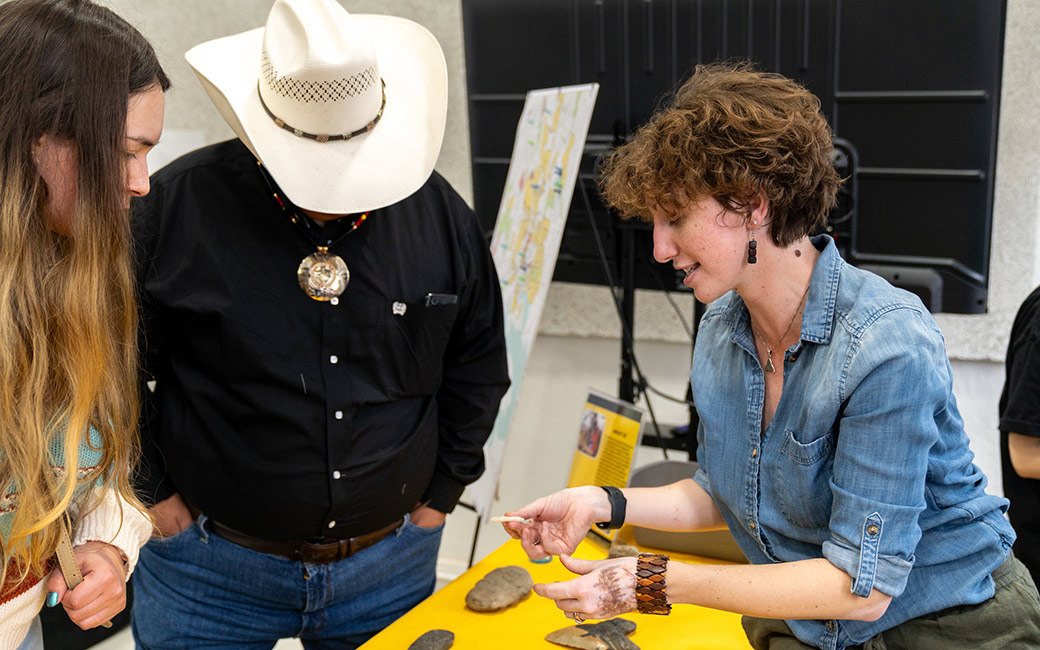Ancient artifacts create opportunities for connection
A partnership between TU archaeologists, Indigenous stakeholders is building more balanced historical narratives
By Pamela Gorsuch on April 15, 2024

Six miles from the edge of TU’s campus, just below the ground, there are remnants of an ancient hunting camp. There, more than a thousand years ago, an Indigenous person made tools and prepared game for transport.
This glimpse into life in our region was pieced together by Katherine Sterner, Ph.D., and TU archaeology students in the College of Liberal Arts. Working side by side this spring, they excavated more than 300 pieces of debris and a dozen stone tools from what is now known as Herring Run Park in northeast Baltimore. The dig is the latest project for the Baltimore Community Archaeology Lab (BCAL), a TU program that pairs archaeology students with community partners to document and preserve cultural resources across the region.
Just weeks after their discovery, Sterner and her team brought the artifacts a few miles south to a round dance and culture class hosted by Native American LifeLines and the Baltimore American Indian Center. There, they shared their findings with members of the community and discussed the insights they provide on life in the region before European contact.
Related: Advocating for urban natives
Some saw it as an opportunity to deepen their understanding.
“I had no idea these types of materials were being found here,” says Dana Chavis, a Baltimore resident and member of the Lumbee Tribe. “The students were telling me things I didn’t know about people who lived in my own backyard.”
An Indigenous voice in historical narratives
Connection with Native American communities is key for Sterner. As director of the BCAL, she works closely with Indigenous organizations to ensure they have a voice in constructing the historical narratives resulting from her investigations. Tribal communities have the opportunity to weigh in during the research design phase and can participate in the interpretation of research results so, together, they can preserve the cultural heritage and share the history of the area now known as Baltimore.
“We are in a situation that’s ripe for tribes to be more of a presence in the way people think about Maryland history,” Sterner said. “It’s important to involve the urban Native American population in Baltimore in this work.”
Real-world applications
Another principle of the BCAL is providing real-world learning opportunities for students. Since TU has the only local archaeology program in greater Baltimore, it’s critical that graduates are well-prepared to enter the workforce. That means having not just a degree but also field work experience, which is a requirement for even entry-level positions. The BCAL’s contract work enables students to gain that invaluable experience and to get paid while doing it. For students like Keely Vie Brock, it brings the coursework to life.
“I never imagined I’d have this opportunity in my first year at Towson,” Vie Brock says. “I’m learning so much, not only in class but also through hands-on experience in the field and with Dr. Sterner.”
Sterner says the combination of discovery and community is what it’s all about.
“We want to allow for cross pollination between those interested in studying Native American history and artifacts and those who understand current practices and traditions,” Sterner says. “That’s how we draw connections between the two.”
Celebrate culture & community
Join us in celebrating Native heritage and cultures and the many ways they remain vibrant and present today.
Learn more about how the Baltimore Community Archaeology Lab is strengthening historic preservation in the greater Baltimore area.